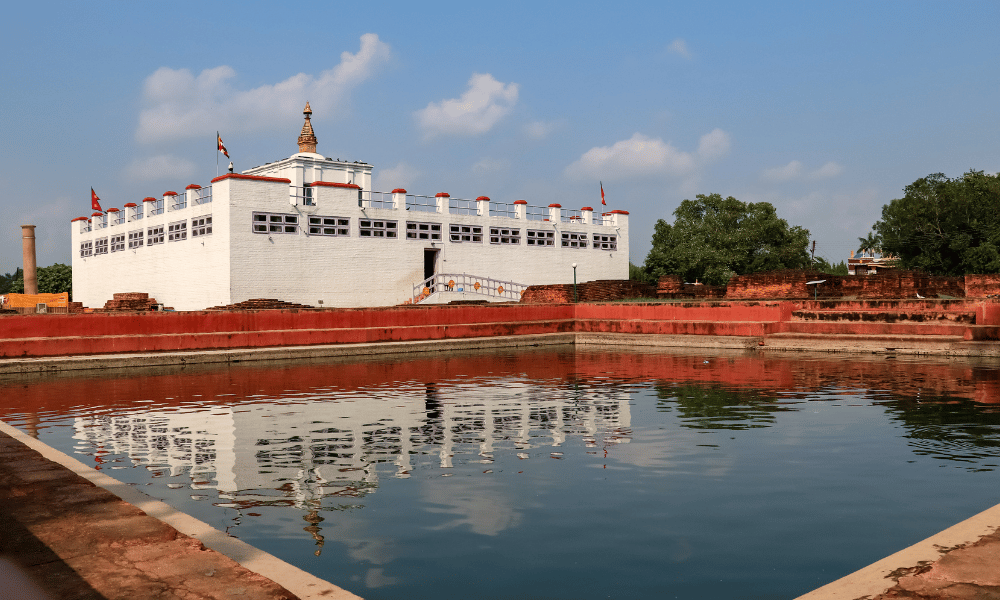Lumbini, nestled in Nepal's serene plains in the Rupandehi district, is world-renowned as the birthplace of Gautam Buddha. This special site is more than simply a physical location; it represents peace and enlightenment. The ancient Maya Devi Temple marks the hallowed site, as it enshrines the exact area where Queen Mayadevi gave birth to Prince Siddhartha around 623 BCE. The serene Lumbini Garden, which surrounds the temple and includes the Ashoka Pillar as well as several stupas and monasteries built by Buddhist communities from all over the world, provides a quiet break from the hustle and bustle of modern life. Lumbini holds profound spiritual significance for Buddhists and numerous other individuals.
Lumbini's history as a spiritual location goes back over two millennia. It has long been revered as a pilgrimage destination for Buddhists seeking to honour the birthplace of Buddha. Archaeological discoveries, such as the ancient ruins and the Ashoka Pillar, give compelling evidence for Lumbini's claim to be Buddha's birthplace. These findings have solidified its place as an important location in Buddhist teachings and philosophy. Furthermore, the Lumbini Master Plan, led by renowned architect Kenzo Tange, intends to protect the site's holiness while accommodating the increasing number of tourists, ensuring that Lumbini remains a beacon of spirituality and historical enquiry. The site comprises the sacred garden where Buddha is said to have been born, as well as other monasteries and monuments created by different countries, all of which contribute to Lumbini's spiritual and cultural tapestry.
A pilgrimage to Lumbini provides an unforgettable experience of peace and introspection. The tranquil environment created by the area's old stupas, monasteries, and the sacred Bodhi tree draws visitors from all over the world. As a World Heritage Site recognised by UNESCO, Lumbini is safeguarded and conserved for upcoming generations. It offers a variety of festivals and ceremonies commemorating Buddha's life and teachings, providing a rich cultural and religious experience for both pilgrims and tourists. While at Lumbini, one can experience inspiration and serenity that are closely linked to Gautam Buddha's teachings, in addition to appreciating the historical and spiritual value of the site.
Also Read: Swayambhunath Stupa
History of Lumbini
The history of Lumbini began with the birth of Gautam Buddha. At around 630 BC, the current Lumbini was under the reign of King Suddhodhan and his Queen Mayadevi. Mayadevi was unable to give birth until seven years into their marriage due to problems. One day she had a dream about a white elephant entering her womb, and as a result, she became pregnant with Prince Siddhartha. During that period, people believed that giving birth in a mother's parental house was a wonderful thing. Mayadevi planned to travel to her maternal home, Devdaha, during the delivery period. The journey was long, and Mayadevi and her servants had to make overnight breaks at various locations along their journey. On one such faithful day, she had to halt in Lumbini, which was then a magnificent garden. She laboured and gave birth in a standing position while holding a tree branch to a miraculous baby who was claimed to have walked 7 steps where lotus bloomed before pointing his index finger to the sky, marking his birth as the final Buddha. Queen Mayadevi died a few days after his birth. Following her death, the prince was raised by Mayadevi's sister, who became his foster mother. Later in his life, he escaped the royal life and pursued enlightenment. After attaining buddhahood, he began passing on his knowledge to others, eventually becoming the most well-known buddha among the other buddhas. Later in his life, Lord Buddha advised his followers to visit four sacred places relevant to his life, one of which was his birthplace. This is the reason why Lumbini is considered the most significant religious site and pilgrimage destination for Buddhists all around the world.
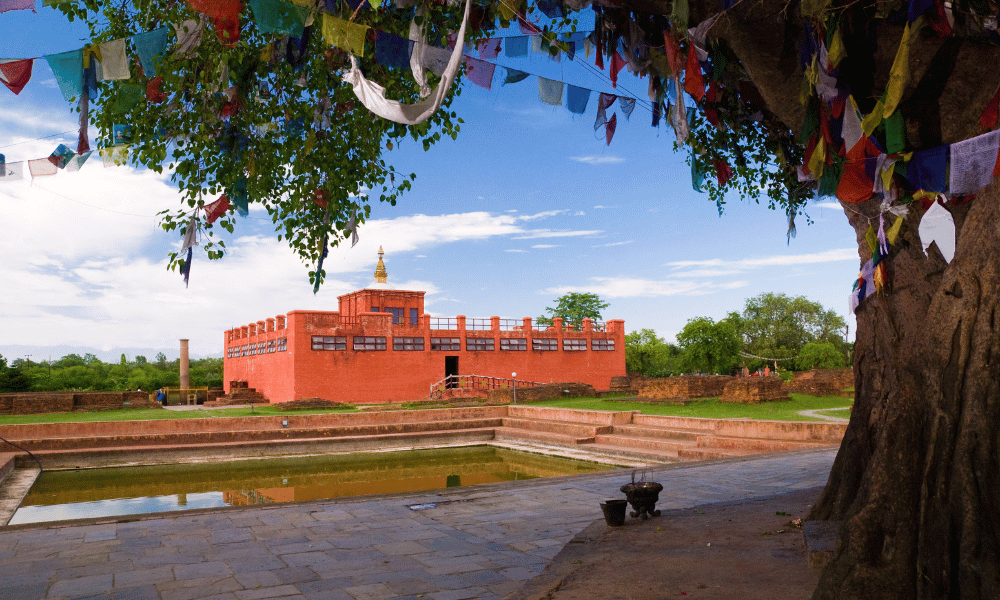
Lumbini quickly became a popular pilgrimage destination following Lord Buddha's parinirvana. This claim is supported by the Great Emperor Ashoka's royal visit to Lumbini around 249 BC. During his visit, he erected a pillar in the Lumbini garden near Buddha's actual birth spot, which he marked with a large marker stone. During his visit, he also decreased Lumbini's tax by eight parts, which helped the local economy at the time. Similarly, many other notable personalities have undertaken pilgrimages to Lumbini, demonstrating the importance of this sacred site. King Ripu Malla of the Malla dynasty paid the final known and well-documented visit in the early 14th century. He was known for his benevolence and enthusiasm, which made him a peace-loving king. During his visit to Lumbini in 1312 AD, he left an inscription in Nigali Sagar that says "Om Mani Padme Hum Sri Ripu Malla Chidam Jayatu Sangrama Malla" (May Prince Ripu Malla reign long and victorious). Following his visit, Lumbini, the birthplace of Gautama Buddha, vanished and gradually became a forest as Buddhism declined in the Indian subcontinent.
Later, in 1896 AD, Khadga Shumsher Jung Bahadur Rana discovered the Nigali Sagar and then the Ashoka Pillar, both of which had inscriptions. He requested assistance from Dr. Alois Anton Führer, a German archaeologist, in decoding the inscription, which was written in the ancient Brahmi and Pali languages. After the inscriptions were deciphered, it was discovered that it was the birthplace of Siddhartha Gautam Buddha, and the news spread throughout the world. Several excavation and conservation projects have been completed since that time, making Lumbini a noteworthy Buddhist place in the world today. To preserve its significance, the International Committee for the Development of Lumbini, with the assistance of renowned architect Kenzo Tange, created a master plan for Lumbini that includes the sacred garden, two monastic zones, a museum, a cultural centre, a new Lumbini village, and more. The work is still ongoing, with numerous worldwide monasteries being erected to represent religious concord and cultural heritage.
Lumbini Pilgrimage
In the Parinibbana Sutta, an important discourse in Buddhist scriptures, the Buddha himself mentioned four significant places of pilgrimage associated with his life, which are the place where he was born (Lumbini), the place where he got enlightened (Bodh Gaya), the place where he gave his first Sermon (Sarnath), and the place where he attained parinirvana (Kushinagar). Lumbini holds a special place among these as the site of his birth. This event is regarded as one of the most pivotal moments in human history, marking the birth of a spiritual teacher whose teachings would profoundly impact millions of lives for centuries to come.

For Buddhists, visiting Lumbini is not just a symbolic act but a deeply meaningful pilgrimage to the very place where their spiritual journey began. Excavations in Lumbini have unearthed ruins and artefacts that provide insights into the ancient civilisations that revered this site long before it gained international prominence. The Great Emperor Ashoka erected the Ashoka Pillar, which stands as a living reminder of the significance of pilgrimage to this holy site since ancient times. The Maya Devi Temple, built at the exact spot where the Buddha was born, serves as the focal point of reverence and devotion. Pilgrims from all over the world come to pay homage, offer prayers, and meditate in this sacred space, seeking inspiration and blessings. The tranquility and sanctity of Lumbini provide a conducive environment for introspection and spiritual growth, allowing pilgrims to connect with the essence of the Buddha's teachings and find inner peace.
Lumbini's significance as the birthplace of the Buddha extends beyond religious boundaries, attracting scholars, historians, and tourists interested in exploring the origins of Buddhism and its historical context. The meticulous preservation and development efforts undertaken in Lumbini ensure that future generations can continue to experience the profound legacy of the Buddha's birth and the enduring impact of his teachings. Thus, Lumbini stands as a testament to the timeless wisdom and universal compassion embodied by the Buddha, inviting all who seek enlightenment to embark on a transformative pilgrimage to the birthplace of one of the world's greatest spiritual leaders.
Related Tour: Nepal 10 Days Tour Package
Cultural and Religious Significance
Lumbini has enormous cultural and religious significance as the birthplace of Siddhartha Gautama Buddha. This historical and spiritual location is one of the holiest places in Buddhism, drawing people from all over the world. The Maya Devi Temple, which symbolises the exact location of Buddha's birth, is a major source of devotion and worship. This temple, along with other old ruins and archaeological monuments, serves as a direct link to Buddha's life and the early development of Buddhism. The presence of the Ashoka Pillar, built by Emperor Ashoka in the third century BCE, confirms Lumbini's status as an important pilgrimage destination since ancient times.
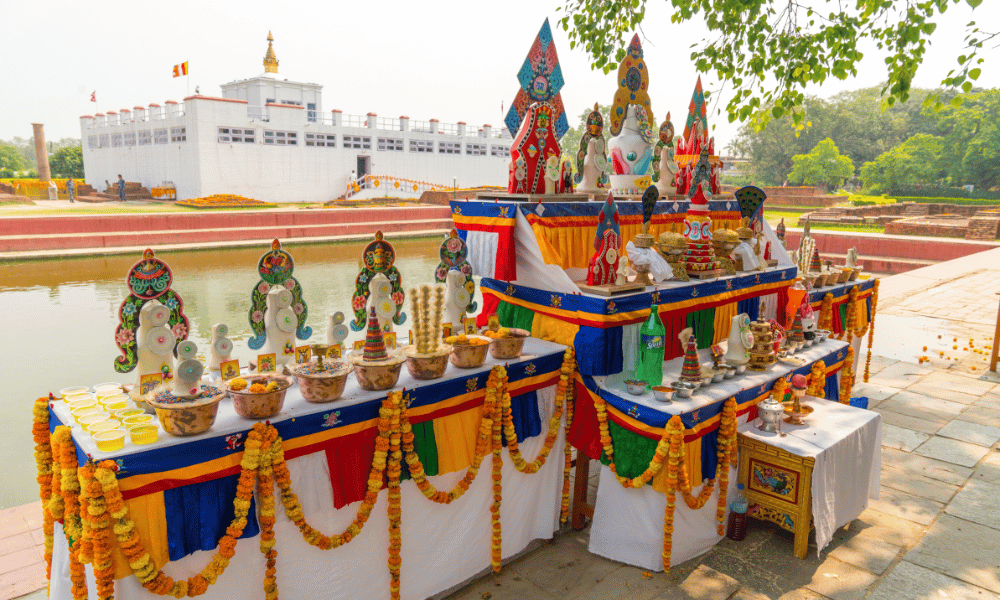
Lumbini's cultural significance extends beyond its religious components, as it represents peace, tolerance, and understanding. The Sacred Garden, which includes the Maya Devi Temple and other historical sites, is a UNESCO World Heritage Site. This recognition emphasises Lumbini's universal value and contribution to intercultural communication and respect. The garden's tranquil environment, decorated with ancient trees and serene ponds, provides a pleasant retreat for meditation and reflection, symbolising Buddha's teachings on compassion and enlightenment. The diverse architectural styles of the monasteries built by various Buddhist communities from around the world within the Monastic Zones also reflect the global impact and cultural integration of Buddhist traditions.
As a focal point of important Buddhist festivals and events, Lumbini's religious significance is further enhanced. Festivals such as Buddha Jayanti, which commemorates Buddha's birth, enlightenment, and death, attract vast crowds of monks, nuns, and lay practitioners from throughout the world, creating a sense of global Buddhist solidarity. These activities are distinguished by rituals, prayers, and cultural acts that enhance attendees' spiritual experiences. Lumbini also plays an important part in pilgrimage, where devotees circumambulate sacred sites, make offerings, and engage in meditation rituals to strengthen their spiritual commitments. Lumbini remains a living centre of Buddhist practice as well as a beacon of peace and harmony for people of all faiths and backgrounds, thanks to these diverse cultural and religious activities.
Also Read: Boudhanath Stupa
Master Plan of Lumbini
The master plan for Lumbini, the birthplace of Siddhartha Gautama Buddha, was designed to transform the area into a significant pilgrimage and tourist destination while maintaining its historical and spiritual significance. The plan was designed by the renowned Japanese architect Kenzo Tange in 1978. It includes a wide range of development efforts aimed at converting Lumbini into a calm and inspiring destination that reflects its historical significance in Buddhism. The Lumbini Master Plan, spread over an area of 1×3 square miles and oriented along the north-south axis, encompasses three major zones: the Sacred Garden, the Monastic Zone, and the New Lumbini Village, each with a specific function to meet the requirements of pilgrims, monks, scholars, and tourists.

The Sacred Garden is the master plan's centre point, housing the most notable sites, including the Maya Devi Temple, which commemorates the Buddha's actual birthplace. The area is intended to have a peaceful atmosphere free of urban noise and commercial activity, allowing visitors to meditate and reflect in a tranquil setting. The garden is enclosed by a circular levee with a canal, which represents the Buddhist cosmology concept of a lotus. This layout preserves and enhances the sanctity of the birthplace, creating a peaceful and reverent ambience.
The Monastic Zone is separated into two sections: eastern and western, which contain monasteries from the Theravada and Mahayana traditions, respectively. This segmentation reflects Buddhism's inclusive nature, which accommodates a wide range of practices and teachings. The New Lumbini Village is intended to serve as a place for visitors to stay and use facilities such as museums, research centres, and hotels. This zone is designed to accommodate the inflow of visitors and students by offering amenities that enhance their experience while preserving Lumbini's cultural and spiritual essence. These master plan components work together to protect Lumbini's historical integrity while also promoting its development as a Buddhist study and pilgrimage destination.
Major Attractions
From ancient temples steeped in legend to tranquil gardens that whisper tales of enlightenment, Lumbini offers a tapestry of experiences that captivate the soul and inspire the mind. Below are some of the must-see attractions that beckon travelers from across the globe to this timeless sanctuary of peace and wisdom.
The Sacred Garden
The Sacred Garden of Lumbini is a tranquil and spiritually significant place that includes the Maya Devi Temple and the Ashoka Pillar. This garden is constantly maintained to retain its serene and introspective ambience, making it a great location for meditation and reflection. The garden's layout includes historic trees, maintained lawns, and a variety of flora that provide a peaceful ambience and encourage visitors to connect with nature and spirituality. The layout of the Sacred Garden is intended to create a meditative journey, with pathways going to many prominent locations within the garden, each presenting a unique perspective on Buddha's life and teachings.
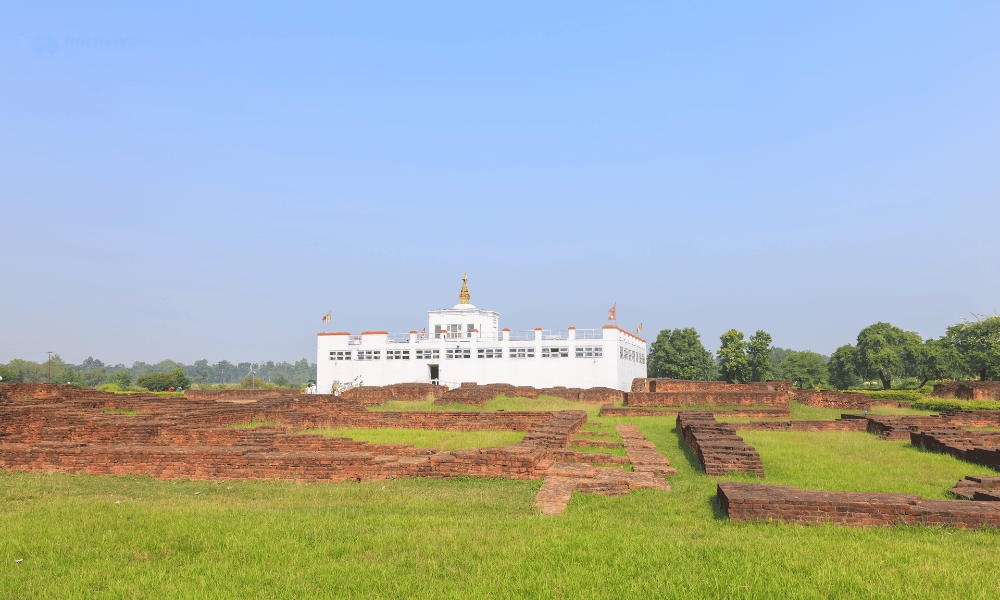
The Ashoka Pillar, built by Emperor Ashoka in 249 BCE to commemorate his visit to Lumbini, stands at the heart of the Sacred Garden. The pillar includes an inscription establishing Lumbini as Buddha's birthplace, which serves as a significant historical and archaeological testament. The garden also contains other old ruins, such as stupas and monasteries, from various periods of Buddhist history. These remains of the past, along with the garden's natural beauty, make the Sacred Garden a location of profound reverence and a major draw for visitors looking to discover Lumbini's spiritual and historical core.
Maya Devi Temple
The Maya Devi Temple, Lumbini's centrepiece, marks the exact birthplace of Siddhartha Gautama Buddha. This ancient temple is one of the most sacred places for Buddhists worldwide. The temple complex contains the ruins of older structures dating back to the third century BCE, built by Emperor Ashoka and later Buddhist dynasties. Inside, visitors can see the sacred marker stone, which marks the exact location where Queen Maya Devi is believed to have given birth to Buddha. The temple also has an idol depicting Buddha's birth scene, with Maya Devi holding a branch of a tree while giving birth.

The surrounding garden area of the Maya Devi Temple contributes to the sacred atmosphere, creating a space suitable for meditation and reflection. This area is beautifully landscaped and features ancient stupas. Ponds and water features, such as the sacred Puskarini or Holy Pond, where Maya Devi is said to have bathed before giving birth, contribute to the site's tranquilly. Because of its natural beauty and historical significance, the Maya Devi Temple is a popular pilgrimage site and tourist attraction in Lumbini.
Ashoka Pillar
The Ashoka Pillar in Lumbini, Nepal, stands as a significant historical and archaeological monument, commemorating the birthplace of Siddhartha Gautama, who later became the Buddha. Erected by Emperor Ashoka of the Maurya Dynasty in the 3rd century BCE, the pillar is one of several he commissioned across the Indian subcontinent to mark key sites associated with Buddhism. Made of polished sandstone, the Lumbini pillar features an inscription in Brahmi script, which records Ashoka's visit to Lumbini and his reverence for the Buddha's birthplace. This inscription also provides valuable historical insights into Ashoka's reign and his efforts to promote Buddhism. The pillar, when first erected, was about 40 feet long and originally had three parts: the monolithic pillar, a lotus bracket, and a crowning figure, which was possibly a horse. The present monolithic pillar is 30 feet, 10.5 inches (9.41 m) long. The middle part of the pillar ‘lotus bracket’ was recently placed on a raised brick platform near the pillar. As mentioned by Hiuen Tsang, the crowning part of the pillar was a horse image, which unfortunately is still missing.
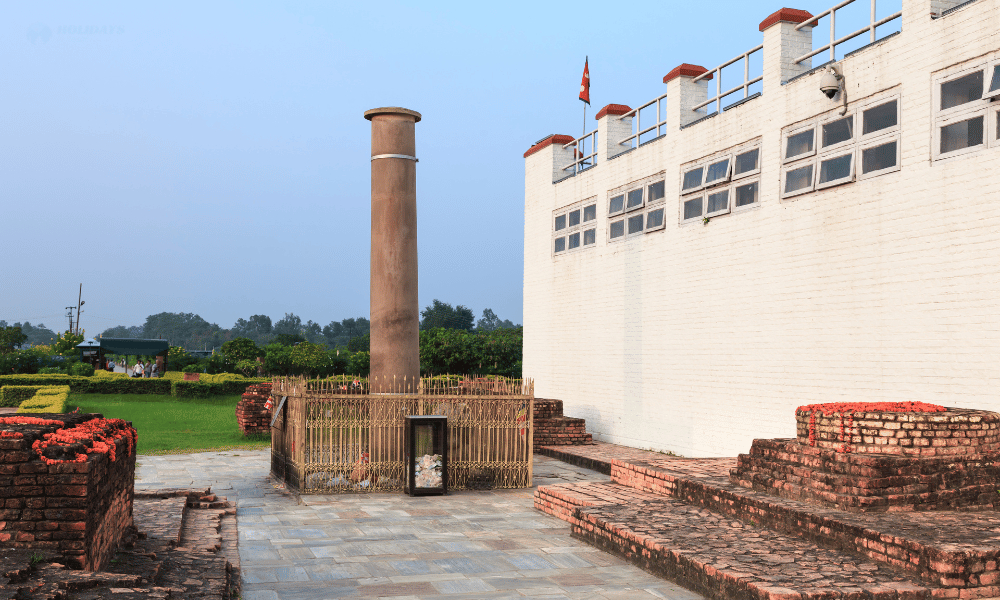
The Asoka Pillar bears the first epigraphic evidence with reference to the birthplace of Lord Sakyamuni Buddha. The text written in Brahmi script and Pali is translated as follows:
“King Piyadasi (Asoka), the beloved of the gods, in the twentieth year of his reign, himself made a royal visit. Sakyamuni Buddha was born here; therefore, the (birth spot) marker stone was worshipped and a stone pillar was erected. The lord having been born here, the tax of the Lumbini village reduced to the eight parts (only)”.
The Ashoka Pillar is located within the Lumbini Garden, which is a UNESCO World Heritage Site. The presence of the pillar underscores Lumbini's importance as a pilgrimage destination for Buddhists around the world. It stands near the Mayadevi Temple, which is believed to mark the exact spot where Queen Mayadevi gave birth to Siddhartha Gautama. The surrounding area includes various stupas, monasteries, and meditation centres built by Buddhist communities from different countries, creating a serene and culturally rich environment. The Ashoka Pillar not only serves as a tangible link to ancient history but also symbolises the enduring legacy of Buddhism and the universal message of peace and enlightenment that Buddha propagated.
West Monastic Zone
The West Monastic Zone in Lumbini is a significant area dedicated to Theravada Buddhist monasteries. This peaceful area is home to monasteries built by Buddhist communities from all over the world, each with their own architectural style and cultural heritage. Walking through the West Monastic Zone, visitors can see the diversity of Buddhist practice represented by the monasteries built by countries such as Thailand, Myanmar, and Sri Lanka. Each monastery is a self-contained unit with its own distinct design, meditation spaces, and religious practices, adding to a diverse mosaic of Theravada Buddhist traditions. There are currently 14 monasteries (with four more under construction) and two meditation centres in this zone. Most of them are open to visitors, and you can go in and look at the public areas.
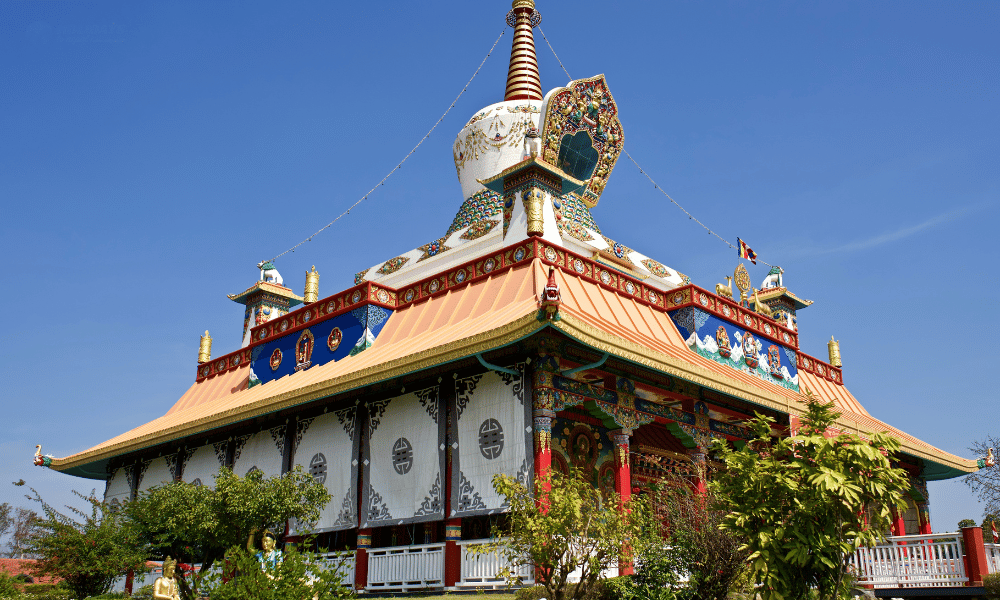
The West Monastic Zone is intended to provide a peaceful and reflective environment. The paths between monasteries are lined with trees and landscaped gardens, creating a peaceful environment for meditation and contemplation. Visitors can take part in meditation sessions, learn something new, or simply relax in the peaceful surroundings. This area is less crowded than other parts of Lumbini, making it an excellent choice for those seeking peace and quiet. The presence of monks and nuns, combined with the regular chanting and rituals, contributes to the spiritual atmosphere, making the West Monastic Zone an exceptional location for spiritual growth and understanding.
East Monastic Zone
The East Monastic Zone in Lumbini is dedicated primarily to Mahayana and Vajrayana Buddhist traditions, showcasing a vibrant array of monasteries built by Buddhist communities from diverse countries such as China, Japan, Korea, and Nepal. This zone is a testament to the global nature of Buddhism, with each monastery reflecting the architectural and cultural heritage of its home country. Visitors can explore beautifully constructed temples and stupas, each with intricate designs, statues, and murals that depict various aspects of Buddhist teachings and stories. The East Monastic Zone offers a unique opportunity to experience the richness of Mahayana and Vajrayana practices within a single area. There are fewer monasteries in the East Monastic Zone compared with the area on the western side, and there are currently only five monasteries (with three more under construction) and one meditation centre.
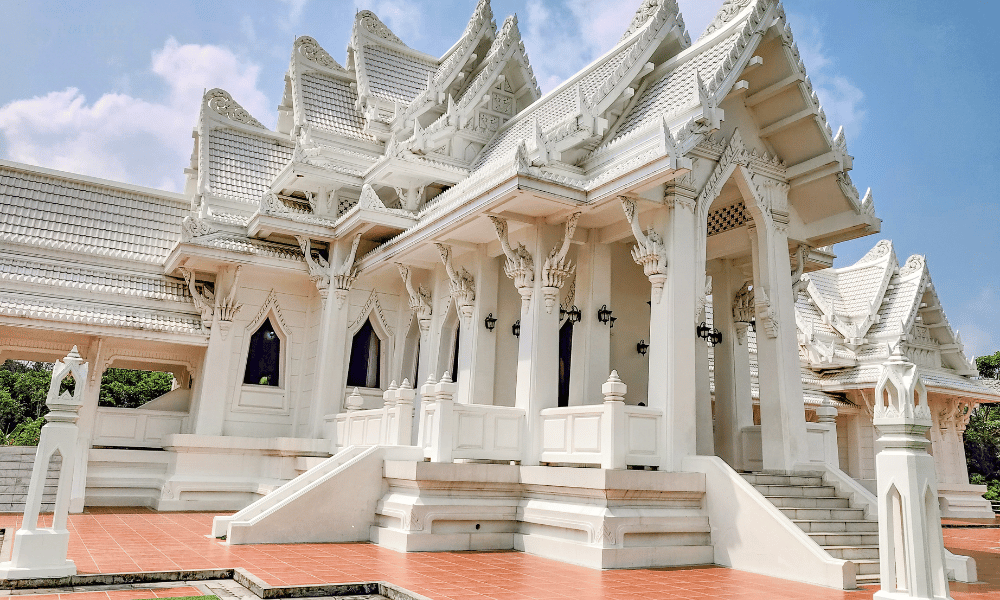
Like its western counterpart, the East Monastic Zone is designed to be a peaceful and contemplative space. The lush green surroundings, interspersed with water features and shaded walkways, create an inviting atmosphere for meditation and reflection. Many monasteries in this zone offer meditation classes, religious ceremonies, and cultural programmes, providing visitors with deeper insights into Mahayana and Vajrayana philosophies. The serene environment, combined with the vibrant cultural expressions of Buddhism, makes the East Monastic Zone a significant and enriching attraction in Lumbini.
Tilaurakot (Capital of ancient Kapilvastu)
Tilaurakot, believed to be Kapilvastu's ancient capital, is historically and archaeologically significant as the location where Prince Siddhartha spent the first 29 years of his life before embarking on his journey to enlightenment. The archaeological site is approximately 27 kilometres west of Lumbini and contains extensive ruins of what is thought to be the Shakya palace complex, where Siddhartha lived as a royal prince. Excavations at Tilaurakot have uncovered fortified walls, gateways, residential areas, and a variety of artefacts that shed light on ancient Kapilvastu's life and times.
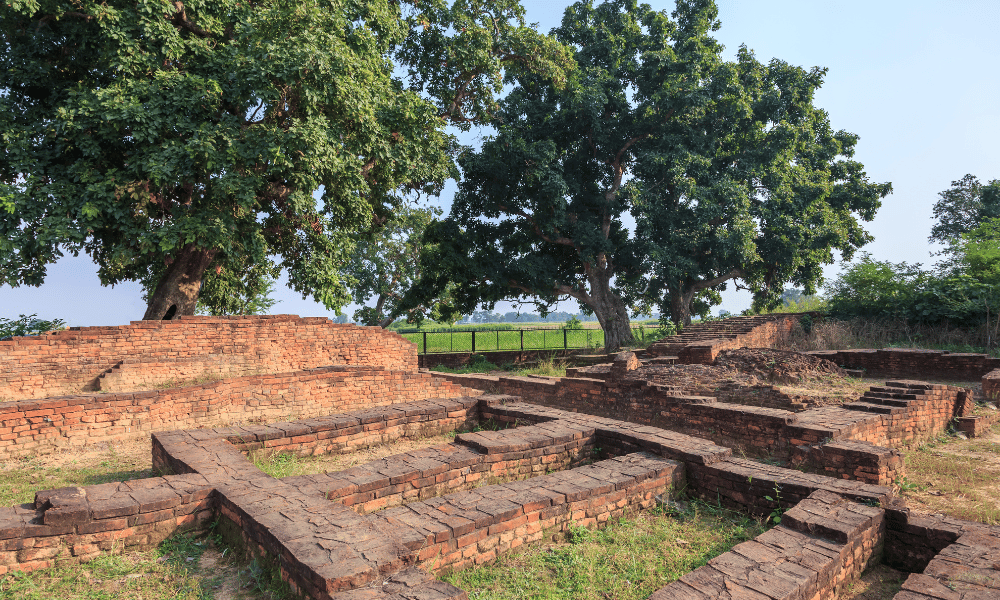
Visiting Tilaurakot provides a unique historical perspective on Buddha's early life. The site is spread out over a large area, and there are paths that lead to different parts of the old city. Information boards and guided tours help to interpret the significance of the ruins, which improves the visitor experience. The serene and relatively peaceful environment surrounding Tilaurakot creates a contemplative atmosphere, allowing visitors to reflect on Prince Siddhartha's transformative journey from royalty to enlightenment. Tilaurakot is a must-see destination for those interested in Buddhism's historical and spiritual roots.
Devdaha (Maternal Home of Mayadevi)
Devdaha, about 54 kilometres from Lumbini, is revered as Maya Devi's maternal home and the early childhood home of Siddhartha. This site is significant in both history and religion because it is believed to have been the ancient capital of the Koliya kingdom, Buddha's maternal clan. Devdaha has a number of attractions, including ancient ruins, stupas, and shrines related to Buddha's early life and family. The site is also associated with several significant events in Buddha's life, including his visits to the area to preach to the Koliyan people after achieving enlightenment.
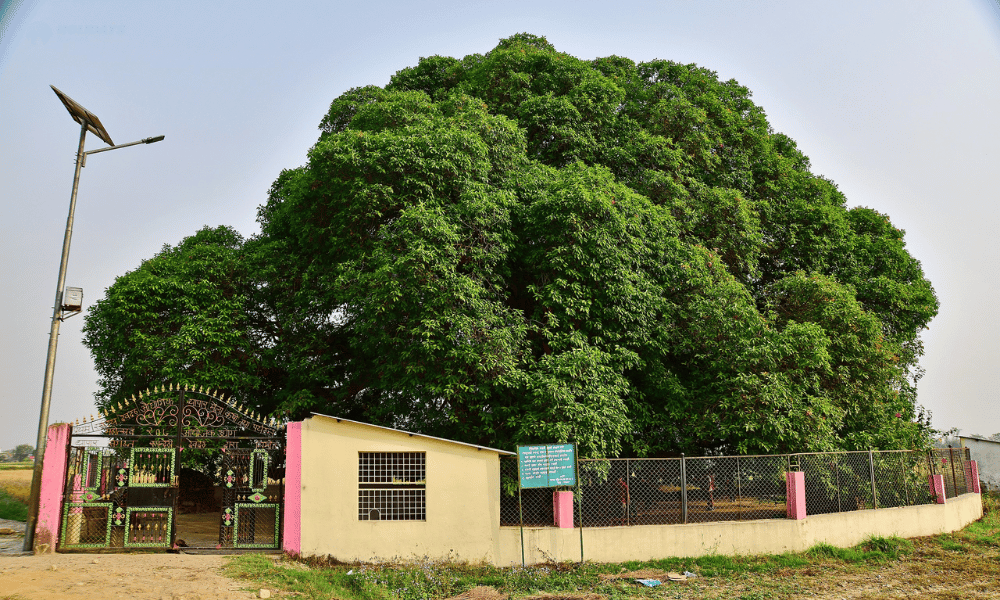
The serene environment of Devdaha, with its lush green landscapes and tranquil surroundings, offers visitors a peaceful retreat. The natural beauty of the area, combined with its historical significance, makes it an ideal place for meditation and reflection. Local communities continue to honour Devdaha's traditions, preserving its cultural and spiritual heritage. Visitors can explore the various stupas and ancient structures that dot the landscape, learning about the historical context of Buddha's early life as well as his maternal lineage. Devdaha is thus an important pilgrimage site for those seeking to gain a better understanding of Buddha's life and the origins of his teachings.
Eternal Peace Flame
The Eternal Peace Flame, which can be found at the southern end of the canal in Lumbini, represents global peace and harmony. It was lit in 1986 as part of the International Year of Peace and has been burning continuously ever since, symbolising Buddha's timeless message of peace to the world. The flame is housed in a simple yet elegant structure, and it serves as a focal point for visitors to reflect on the Buddhist philosophy's core principles of nonviolence and universal brotherhood.
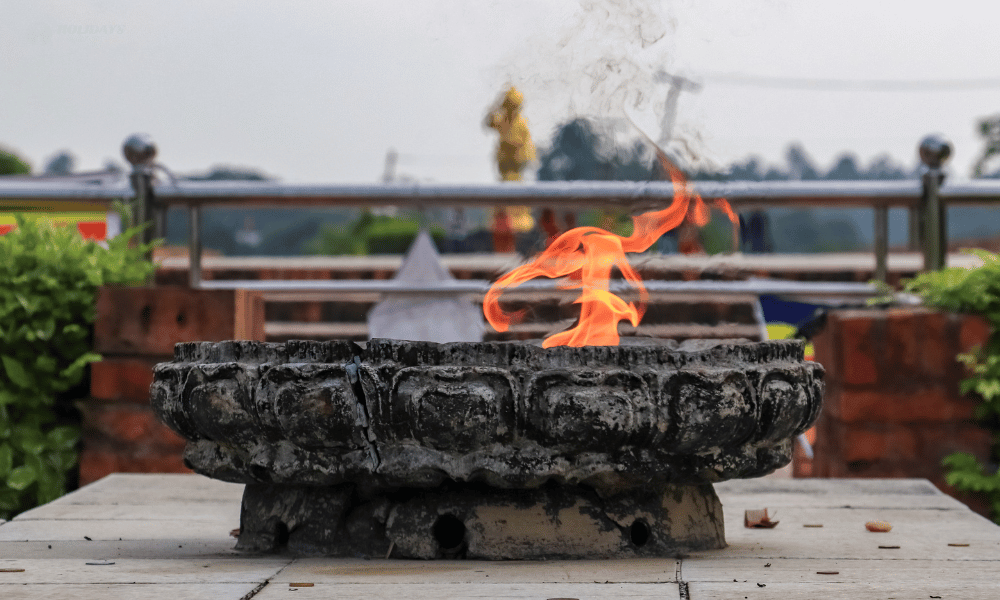
The area surrounding the Eternal Peace Flame is beautifully landscaped, adding to the site's serene and reflective atmosphere. The flame's eternal nature reminds visitors of the enduring importance of peace in a world frequently affected by conflict and division. Regular ceremonies and gatherings around the flame bring people from various cultures and backgrounds together to commit to peace. The Eternal Peace Flame thus serves as a powerful symbol of hope and a testament to Buddha's unifying teachings, making it a popular attraction in Lumbini.
Lumbini Museum
The Lumbini Museum, situated near the Sacred Garden, is dedicated to preserving and showcasing the rich history and cultural heritage of Lumbini and Buddhism. The museum houses a vast collection of more than 200 artefacts, including ancient sculptures, inscriptions, coins, and manuscripts that chronicle the life of Buddha and the development of Buddhism over the centuries. The very earliest artefacts date from the 6th BCE but the majority of them date from the 1st to 3rd CE. The exhibits provide a comprehensive overview of Buddhist art and culture, with items from various periods and regions, highlighting the spread and influence of Buddhism across Asia and beyond.
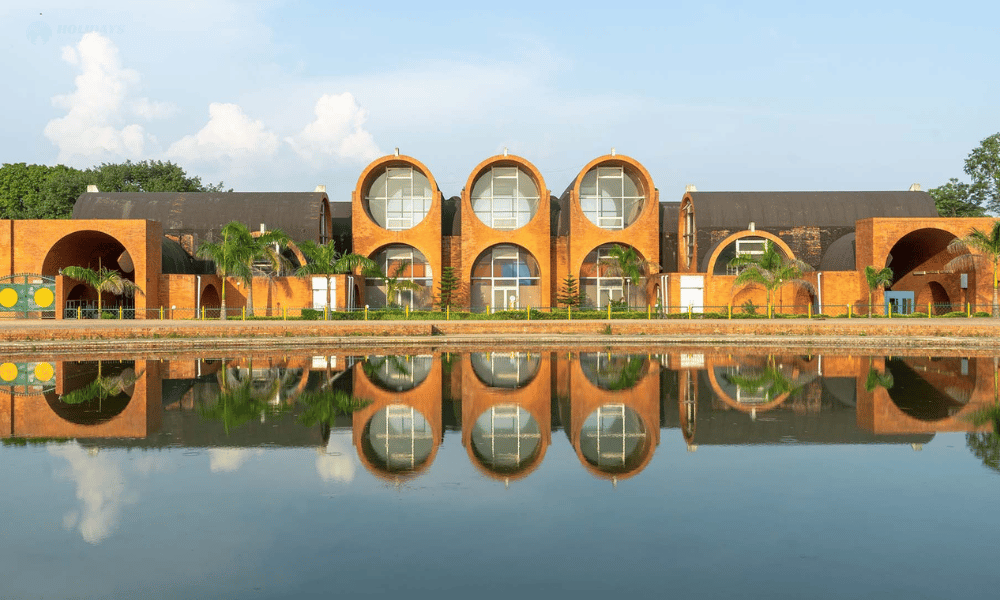
In addition to its extensive artefact collection, the Lumbini Museum offers informative displays and multimedia presentations that enhance the visitor experience. These exhibits provide valuable insights into the archaeological discoveries in Lumbini, the historical context of Buddha's life, and the evolution of Buddhist teachings. The museum also features a library with a wide range of books and publications on Buddhism, making it a valuable resource for scholars and enthusiasts. By preserving and presenting the historical and cultural treasures of Lumbini, the Lumbini Museum plays a crucial role in educating visitors and promoting a deeper understanding of the Buddhist heritage.
Major Festivals and Celebrations
Lumbini is not only a site of historical and archaeological importance but also a vibrant cultural hub where several major festivals are celebrated, attracting pilgrims and visitors from around the world. The major festivals celebrated in Lumbini are:
Buddha Jayanti
Buddha Jayanti, also known as Buddha Purnima, is the most important festival in Lumbini, commemorating the birth, enlightenment, and death (Mahaparinirvana) of Siddhartha Gautama, the Buddha. This auspicious occasion occurs on the full moon day of the Vaisakha month in Hindu and Buddhist calendars, which is usually in April or May. During this time, Lumbini becomes a thriving hub of activity, with thousands of pilgrims and visitors from all over the world gathering to pay their respects and participate in various religious activities. The Maya Devi Temple, Buddha's exact birthplace, is the focal point of the celebrations. Chanting, prayers, and meditation sessions are conducted by devotees, resulting in a deeply spiritual and serene atmosphere.
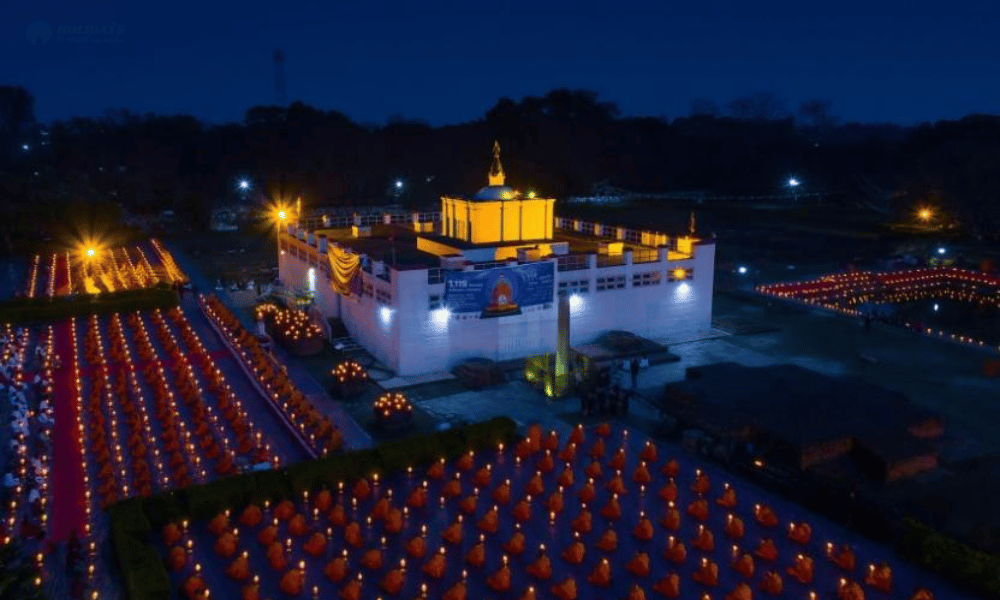
The festival also includes elaborate rituals and ceremonies, such as the symbolic bathing of the Buddha statue, offerings of flowers, candles, and incense, and processions carrying Buddha's sacred relics. Monks and nuns from various Buddhist traditions gather to offer special prayers and sermons focusing on Buddha's teachings and life. Cultural events, such as traditional music, dance, and exhibitions, are planned to commemorate the occasion. The entire Lumbini area is illuminated with lights and decorations, heightening the festive atmosphere and making Buddha Jayanti a profound and memorable experience for all attendees.
Losar Festival
Losar, or Tibetan New Year, is a major festival celebrated with great enthusiasm in Lumbini, especially by the Tibetan Buddhist community and other Himalayan ethnic groups. Losar, which typically occurs in February or March, marks the start of the lunar calendar and is a time of purification, renewal, and celebration. The festival features vibrant rituals and activities that reflect Tibetan Buddhism's rich cultural heritage and spiritual traditions. Monasteries and temples in Lumbini, particularly those in the East Monastic Zone, become hubs of festive activity. Monks and devotees hold special pujas (prayers) and rituals to welcome the new year with blessings and positive energy. Chanting sacred mantras, burning incense, and offering symbolic foods and drinks are all common parts of the festivities.
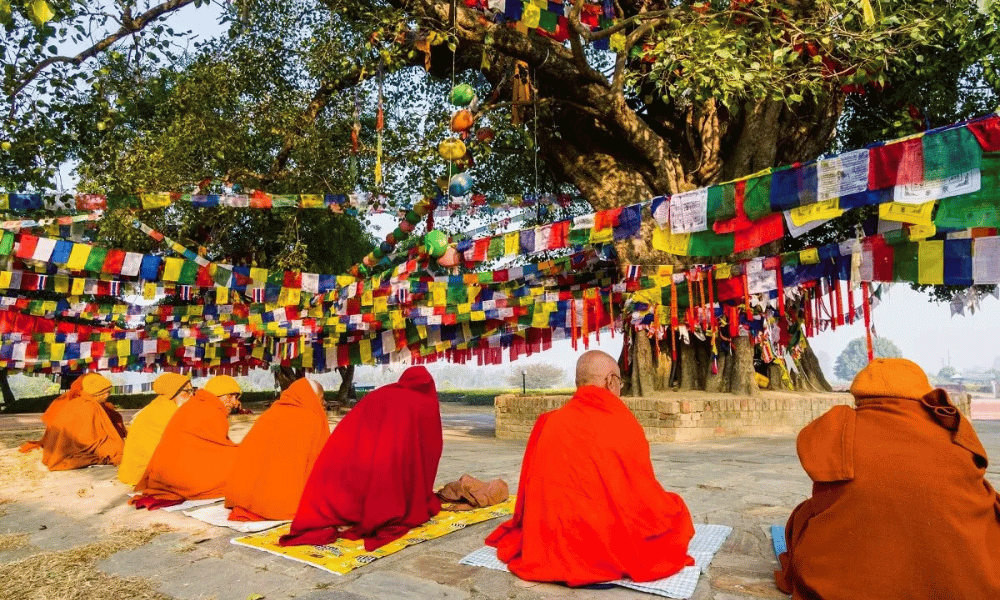
Celebrations go beyond religious observances to include vibrant cultural performances and social gatherings. The festival's highlights include traditional Tibetan music and dance, such as the cham dance performed by masked monks, which represents the triumph of good over evil. Prayer flags, flowers, and lights are used to decorate homes and public spaces in Lumbini, creating a festive atmosphere. People dress in traditional attire and attend feasts that include special dishes such as khapse (deep-fried cookies) and chang (barley beer). Losar is a time for family reunions, community bonding, and the expression of wishes for peace, prosperity, and happiness in the new year. This vibrant celebration not only strengthens the cultural identity of Lumbini's Tibetan and Himalayan communities, but it also attracts tourists interested in Losar's unique traditions and spiritual richness.
Related Read: Losar Festival In Nepal
Travel Tips
If you are planning a trip to the holy city of Lumbini, here are some suggestions that could prove useful to you:
Best Time to Visit:
The ideal time to visit Lumbini is during the cooler months from October to March. The weather is pleasant, making it suitable for exploring the outdoor sites. Visiting during Buddha Jayanti in April or May can also be a profound experience, though it might be crowded.
Clothing and Footwear:
Dress modestly to show respect for the religious sites. Light, breathable clothing is advisable for the warmer months, while a light jacket or sweater may be necessary for the cooler evenings. Comfortable walking shoes are essential, as many sites require significant walking. You should also remove your shoes before entering the monasteries.
Respectful Behavior:
As a sacred site, it’s important to maintain a respectful demeanour. Refrain from loud conversations, and always ask for permission before taking photographs, especially inside temples and monasteries. Remove your shoes before entering any religious building.
Local Transportation:
Lumbini is best explored on foot or by renting a bicycle. There are also electric rickshaws available for hire. The main attractions are spread out, so plan your transportation accordingly.
Accommodation:
There are various accommodation options, ranging from budget guesthouses to more comfortable hotels. It’s advisable to book in advance, especially during peak tourist seasons and major festivals like Buddha Jayanti.
Guided Tours:
Hiring a local guide can enrich your visit by providing detailed historical and cultural insights into the various sites. Many guides speak multiple languages and can offer a deeper understanding of the significance of Lumbini.
Photography and Videography:
While most international monasteries allow visitors to record and photograph inside, it is usually advisable to verify the permission. Making tiktocks near monasteries is strictly prohibited. You can record or photograph the outside surroundings while in the sacred garden area, but not within the Maya Devi Temple itself. If you wish to film with a video camera or professional equipment, you must pay a separate fee.
Entrance Fee and Opening Hours
During your trip to Lumbini, it will be of great assistance to you if you are aware of the rates for entering the monasteries as well as the hours during which they are open.
Entrance Fee
Visiting the Sacred Garden, which includes the Maya Devi Temple, Ashoka Pillar, and other significant sites, usually requires an entrance fee, while other international monasteries outside of the sacred garden don’t require entry fees, but some ask for donations. Please note that these fees may be subject to change, so it is advisable to check the latest updates before your visit.
|
Nationality |
Cost |
|
Foreign Nationals |
NRP 700 |
|
SAARC Nationals |
NRP 400 |
|
Indian Nationals |
NRP 80 |
|
Nepali Citizen |
NRP 20 NRP 10 (For Students) |
Opening Hours
The Lumbini Development Zone is open daily, with the following schedule:
April to September: 6:00 AM to 6:00 PM
October to March: 6:00 AM to 5:00 PM
The timing is designed to allow visitors to explore the site during daylight hours, ensuring a safe and enjoyable experience.
Note: The international monasteries remain closed for an hour after 12 o'clock for a lunch break.
How to Reach
By carefully planning your journey and choosing the most suitable mode of transportation, you can ensure a smooth and enjoyable trip to Lumbini, the birthplace of Buddha and a significant pilgrimage destination. Here are some ways you can reach Lumbini:
By Air:
The nearest airport to Lumbini is Gautam Buddha Airport in Bhairahawa (also known as Siddharthanagar), which is about 22 kilometres away. This airport primarily handles domestic flights from major cities in Nepal, such as Kathmandu and Pokhara. There are frequent flights from Tribhuvan International Airport in Kathmandu to Bhairahawa, making it a convenient option for international travellers arriving in Nepal. From the airport, you can hire a taxi or take a bus to reach Lumbini.
By road from Kathmandu:
A drive from Kathmandu to Lumbini covers approximately 300 km and typically takes around 7 to 9 hours, depending on road conditions and traffic. Departing from Kathmandu, travellers follow the Prithvi Highway towards Narayanghat, where the road continues southward towards Butwal. From Butwal, it's a westward drive to Lumbini. While private cars or taxis offer convenience and flexibility, travellers can also opt for tourist vans or jeeps, especially for group travel. This option allows for personalised stops along the way to admire breathtaking vistas, savour local cuisine, or explore charming towns en route.
From India:
Lumbini is also accessible from India, particularly from the nearby border towns. The closest border crossing is at Sunauli, which is about 30 kilometres from Lumbini. Sunauli is well-connected to Gorakhpur, a major city in Uttar Pradesh, India, which has a railway station with connections to various parts of India. From Gorakhpur, you can take a bus or taxi to reach the Sunauli border, and from there, another bus or taxi to Lumbini.
Conclusion
Lumbini is a symbol of spiritual enlightenment and cultural heritage, revered as the birthplace of Gautam Buddha. This sacred site is truly remarkable, as it provides a profound combination of spiritual depth, historical richness, and tranquil beauty. The ancient history maintained in its hallowed sites, together with the visionary Master Plan, assures that current pilgrims and visitors respect and appreciate the spirit of this holy place. Walking through Lumbini offers a rare opportunity to connect directly with Buddha's life and teachings, providing an educational and deeply moving experience.
Lumbini holds enormous cultural and religious value. Visitors can witness firsthand the religious sites that have drawn pilgrims for ages, such as the Maya Devi Temple, the Ashokan Pillar, and the Sacred Garden. The monasteries, which reflect the architectural and spiritual traditions of various Buddhist groups around the world, contribute to the area's strong sense of togetherness and reverence. Furthermore, the vivid festivals and festivities held throughout the year provide a rich tapestry of cultural expressions and practices honouring Buddha's legacy, making each visit to Lumbini unique and memorable.
For those seeking a journey into the heart of Buddhist culture and history, Lumbini is an unparalleled destination. Whether you are a devoted pilgrim or a curious visitor, Lumbini welcomes you with its serene environment and deep spiritual resonance. The useful travel information and accessible routes provided in the blog aim to make arranging a trip simple and convenient. By beginning on this enlightening journey, you will immerse yourself in a place where history, spirituality, and serenity come together magnificently, providing you with an enriching and transformational experience. We encourage everyone to visit Lumbini and experience its tremendous peace and spiritual depth.

